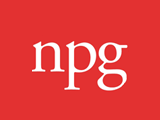
Nature Communications is to become the first Nature-branded open access only journal. The number one open access journal in multidisciplinary sciences*, Nature Communications is Nature Publishing Group’s (NPG) flagship open access title. Nature Communications will only accept open access research submissions from 20thOctober 2014.
Nature Communications ranks as the number three multidisciplinary journal in the world behind Nature and Science*. The title was launched in 2010 as a born-digital hybrid journal, publishing both open access and subscription content. Nature Communications is now one of NPG’s fastest growing titles, receiving over 1500 submissions every month. All research published by the journal represents important advances, of significance to specialists within a field, in all areas of the biological, physical, chemical and earth sciences.
Sam Burridge, Managing Director for Open Research, Nature Publishing Group/Palgrave Macmillan said: “We want to be leaders in open research, and this move accelerates our commitment to drive open access forward. NPG has made significant moves over the past ten years, and 38% of the research articles we published last year were open access. We are now taking a decisive step. We continue to see demand from authors for subscription publishing options, but we also see a need for a high quality, multidisciplinary, open access journal. Most importantly: we believe in open access. Nature Communications is now the Nature-branded flagship journal for high-quality, open access research.”
NPG is also making further policy moves with this development. Nature Communications now offers the CC BY 4.0 license as default, with other Creative Commons (CC) licenses available upon request. There is no price difference for the choice of CC license. APC waivers will be available for HINARI countries, and to others on a case-by-case basis.
Robert Kiley, who leads on the implementation of the Wellcome Trust’s open access policy, commented: “I am delighted that Nature Communications is to become a fully, open access journal, and one that defaults to publishing content under the CC BY licence. The decision by NPG to make this journal fully OA also provides evidence that hybrid OA – in which a journal makes content available under both OA and subscription models – can be a transitional phase. We hope that this will encourage other hybrid OA journals to transition to full OA.”
Nature Publishing Group will honour author’s choice of subscription or open access publication, for those authors whose research is currently in review by the journal, and for submissions up to the 19 October 2014. This means that subscription content will continue to be published in 2015, and available to site license customers. Major funders including Wellcome, RCUK, NIH, NSF, HHMI, CAS allow funds to be used for APCs, and NPG will work with authors to help them identify funds for open access publication.
NPG is committed to continue to publish all other Nature-branded titles as subscription journals, and will continue to offer hybrid OA options on all its other journals.
Burridge adds: “We are building a family of open access journals, offering choice to authors. From Scientific Reports, to the Nature Partner Journal series and our hybrid journals with open access options, we can now offer a home for specialist and high impact open access research across the natural sciences. With the launch of Scientific Data and Palgrave Communications, this has also been extended to all types of open research, including open data and the humanities and social sciences.”
A report by the Research Information Network recently found that there is a significant benefit for article views and downloads, as well as a small but significant citation benefit to publishing open access in Nature Communications.



























